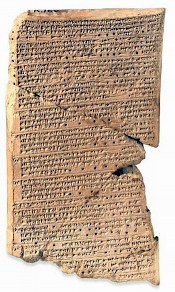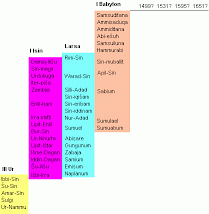Mesopotamian Chronology
General

Although humankind uses many calendars, it is easy to convert a non-western date to the common (originally Christian) era. This is facilitated by the system of Julian Dates, which was introduced in 1849 by astronomer John Herschel: every day has a number, starting with day #1 at 12 o' clock (GMT) on 1 January 4713 BCE. To give an example, this line was written on JD #2,453,783, and it was 0.125 o'clock (or 16 February 2006, tea time). The study of ancient chronology essentially means adding the correct JD-number to the date that is mentioned (or implied) in our sources.
This is easier said than done because the ancients had no agreed-upon era. Even the dates of the ancient Romans, which look a lot like our dates, cannot be used at face value. For example, the day mentioned for the battle of Pydna (4 September) is "our" 22 June 168 BCE.
Down to 911
The chronology of the ancient Near East is no exception, but fortunately, the ancient Babylonians were careful astronomers, who designed an accurate lunar calendar with a regularly inserted intercalary month, which was introduced before 503 BCE. Even earlier, the process of intercalation had become standardized, and it possible to convert many dates in the Babylonian calendar to our own era. For example, the second day of the month Addaru in the seventh year of the Babylonian king Nebuchadnezzar is more or less identical to JD #1,503,443 or, to express it in a more accessible form, 16 March 597.note
In this example, the year is indicated as "seventh of Nebuchadnezzar". To convert a date in a Babylonian or Assyrian document to a date in our calendar, one must know the number of regnal years of all kings. Our most accurate source for this information is the Canon of Kings that has been preserved by the Greek astronomer Ptolemy of Alexandria. He mentions most rulers of Babylonia from Nabû-Nasir (747-734) until the capture of Babylon by Cyrus the Great in 539, continues with the Achaemenid kings to the conquest of the Near East by Alexander the Great, adds the Seleucid rulers and ends with the Roman emperors. Because Ptolemy uses this list only to date astronomical phenomena, kings who died during a certain year are usually allowed to give their name to the entire year, and the next ruler is supposed to have ascended to the Babylonian throne on the first day of the new year. (Kings who reigned less than one year are ignored.)
The information on this list is confirmed by the Uruk King List, which mentions all kings from Aššurbanipal (668-631) to Seleucus II Callinicus (246-226), and the Astronomical Diaries, which record the names of kings in connection to celestial phenomena that can easily be dated. There is no need to doubt that the Canon offers a reliable framework for the period down to 747.
It is easy to go beyond this point because the Assyrians had the custom to call every year after an eponymous official called limmu, who was appointed by the king and had to preside the celebration of the New Year festival. Several lists of limmu's have survived, accounting together for every year from 648 down to 892. Because the solar eclipse of 15 June 763 is mentioned, regnal years of Assyrian kings can be dated with a precision of one year. It is possible to go beyond this point, because 892 is known as the twentieth regnal year of king Adad-nirari II. His reign must, therefore, have started in 911.
The second half of the second millennium
After this, the chronological framework depends on three important sources:
- The Assyrian King List.note This list, which is based on the list of limmu officials, mentions 109 kings; the last one is Šalmaneser V (726-722). It survives in three copies. Down to the reign of Aššur-dan I, they offer identical information, and it is therefore reasonable to assume that the list is more or less reliable until his regnal years, 1178-1133. Before 1178, the three documents show divergences.
- The Babylonian King List A is a parallel list. It offers the names and regnal years of all kings from the First Dynasty of Babylon (in the first half of the second millennium BCE) to king Kandalanu, a contemporary of Aššurbanipal. This tablet is unfortunately damaged.
- The Synchronic King List consists of two columns and records more than 125 synchronisms of kings of Babylonia and Assyria. It starts with the Assyrian Adasi (c.1700 BCE) and concludes with Aššurbanipal (668-631).
Combining these sources and several others, it is possible to work further downward to the reign of the Assyrian king Enlil-Nasir II, whose reign can probably be dated to about 1420-1415. Unfortunately, the Assyrian King List does not preserve the regnal years of Enlil-Nasir's father and elder brother, so it is impossible to proceed beyond this point.
The situation in Babylonia is worse. The Canon starts in 747 and is preceded by twelve kings who are hardly more than names. Their regnal years have not been recorded, but it appears that the eldest of the twelve kings, Mar-biti-ahhe-iddina, started his reign in 942. The two centuries between his accession and the beginning of the Canon are sometimes called "Undetermined Dynasties", "Dynasty E", or "Mixed Dynasties", which are euphemisms for "we cannot make sense of it".
The age that precedes these dynasties is better understood. There are synchronisms with Assyria and there is a document that is called King List C. It describes the Second Dynasty of Isin, which ruled Babylonia between 1157 and 1026. This is preceded by the Kassite Dynasty, the kings of which can also be dated with some accuracy down to king Burnaburiaš II (1359-1333).
So, the list of Babylonian kings can be reconstructed down to 1359, and the Assyrian list down to 1420. In this age, there are several synchronisms with Egypt that corroborate the findings presented above. For example, Burnaburiaš II exchanged letters with his Egyptian colleague Akhenaten (1353-1336), who also wrote letters to Aššur-uballit I of Assyria (1353-1318).
High, middle, low, or ultra-low?
The first half of the second millennium is well-documented. The Babylonian King List A can be supplemented by Babylonian king List B, which describes two dynasties, the First Dynasty of Babylon and the (partly contemporary) First Dynasty of the Sealand. The most famous king of the First Dynasty of Babylon is Hammurabi, who united Mesopotamia and in his thirteenth year put an end to the competing Dynasty of Larsa, where king Rim-Sin had reached his sixtieth regnal year.

The Larsa King List mentions all kings of the Dynasty of Larsa, which is known to have been contemporary with another dynasty that was powerful before Hammurabi united Mesopotamia: the First Dynasty of Isin. Even better, there is an Ur-Isin King List, that mentions all kings of Isin and the kings of an earlier dynasty, which is called the Third Dynasty of Ur.
So, in the first half of the second millennium, there is a continuous list that starts with the first king of the Third Dynasty of Ur and continues to the last king of the First Dynasty of Babylon, Samsuditana, who was forced to see how his city was sacked by the Hittites. Unfortunately, it is not known how much time passed between the fall of Babylon (and the end of the "block of kings" of the first half of the second millennium) and the beginning of the reigns of either Enlil-Nasir II (1420-1415) or Burnaburiaš II (1359-1333).
To establish the width of the gap (the "dark age"), everything depends on a set of observations of the planet Venus during the reign of the penultimate ruler of the First Dynasty of Babylon, king Ammisaduqa, and several eclipses. Depending on the identifications of these events, scholars and scientists agree that there are only four possible chronologies, which are usually called "high", "middle", "low", and "ultra-low".
|
|
|
|
|
|
| Sack of Babylon |
|
|
|
|
| Ammisaduqa's reign |
|
|
|
|
| Hammurabi's reign |
|
|
|
|
| Sumuabum's first year |
|
|
|
|
The publication of the ultra-low chronology, as recently as 1998,note has resulted in a series of vehement polemics, from which ad hominem-arguments are not absent. Among the arguments for the ultra-low chronology is the identification of a set of eclipses; a counter-argument is that the Assyrian king list appears to be too long to fit in this framework.
Recent Developments
The debate has continued, many scholars prefering to stick to the conventional Middle Chronology, until 2012, when parts of the limmu-list were published that belonged to the first centuries of the second millennium BCE.note Because in Kanesh in Anatolia, many letters were found that were dated with the limmus of this list, and because these letters were found in rooms that could be dated dendrochronologically, it was possible to establish absolute dates for these limmus, which in turn made it possible to propose a date for a solar eclipse. This eclipse could only fit in a Middle Chronology that is slightly adapted.
Assuming that the Middle Chronology is correct, the Third Dynasty of Ur should be dated to 2112-2004 or 2004-1996.